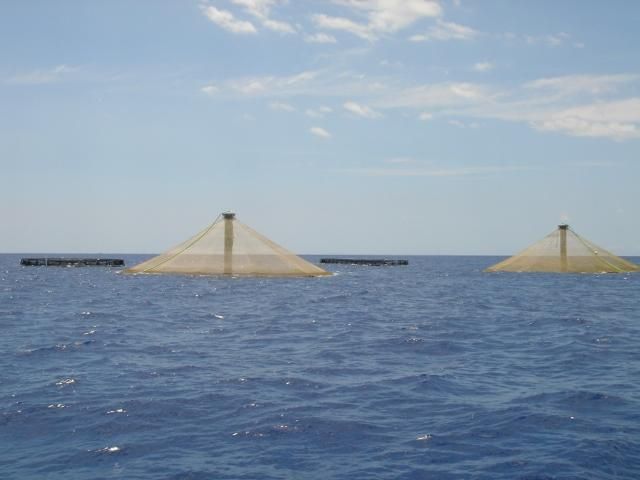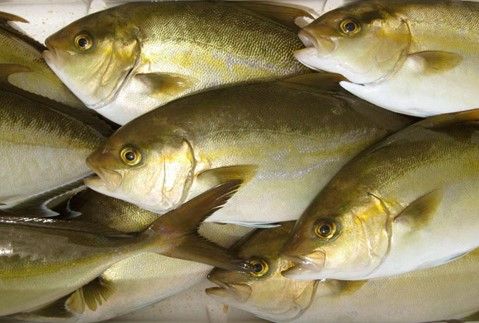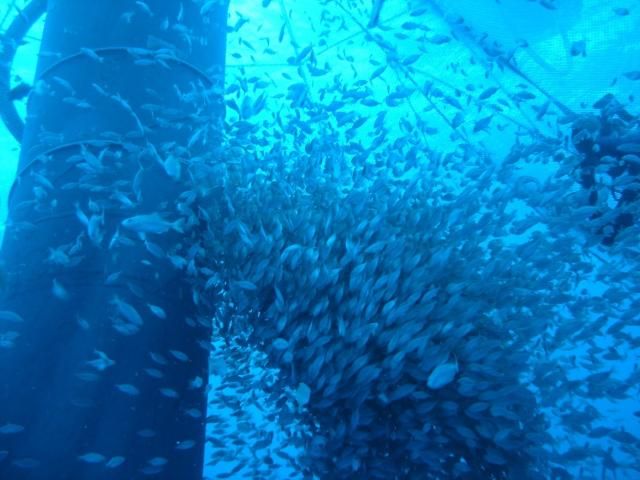Introduction
Aquaculture is a growing industry in Florida, and there is particular interest in offshore marine aquaculture. While inland and nearshore aquaculture (such as for shellfish or ornamental fish) is managed by a Florida state agency, the Florida Department of Agriculture and Consumer Services (FDACS), offshore aquaculture also involves federal management agencies. However, there has been some confusion and disagreement about which federal agencies will manage and make decisions about offshore aquaculture in the United States. This publication describes the recent history and current state of that discussion. This information is important for potential aquaculturists and other stakeholders to understand and should also provide guidance to management and outreach agencies seeking to inform stakeholders about offshore aquaculture.

Credit: © Kampachi Farms, LLC, used with permission
History of US Offshore Aquaculture Governance
Open-ocean aquaculture is broadly defined as the rearing of marine organisms in exposed areas beyond significant coastal influence (Upton and Buck 2019). It is also called offshore aquaculture or offshore fish farming. This typically takes place in the US Exclusive Economic Zone (EEZ) or federal waters, generally 3 to 200 nautical miles from shore for most states, but there are exceptions. For example, on Florida's Gulf Coast, federal waters begin 9 nautical miles from shore but only 3 nautical miles from shore on the Atlantic coast. Offshore aquaculture is currently well established in many countries with research and commercial facilities in Australia, Chile, China, France, Ireland, Italy, Japan, Panama, the Bahamas, Mexico, Vietnam and Norway. In the United States, the situation is different. While there are a few ongoing aquaculture projects sited in federal waters for research purposes, there is only one commercial farm (mussels) in federal waters off California. To date, all other commercial aquaculture facilities have been sited in nearshore waters under state or territorial jurisdiction. Currently, there are no commercial finfish or shellfish aquaculture operations in the Gulf of Mexico (GoM) federal waters, despite a recognized potential for such industry (Knapp and Rubino 2016). The purpose of this document is to describe some of the governance challenges facing offshore aquaculture by detailing the history and current state of offshore aquaculture rule-making and management. This information should be useful to potential aquaculturists interested in offshore aquaculture, as well as management agencies seeking to understand offshore aquaculture's complicated history in the United States.
In the United States, domestic aquaculture production has been identified as a priority for almost 50 years. In the 1970s, the United States was a global leader of aquaculture, and that was when aquaculture rapidly began to expand in the rest of the world. This rapid expansion of global aquaculture is termed the "Blue Revolution." In 1980, Congress passed the National Aquaculture Act in recognition of the importance of domestic aquaculture in meeting future food needs in the United States (S. 1650). The act has been interpreted as an encouragement to further develop aquaculture in the United States, and the Act selected the National Oceanic and Atmospheric Administration (NOAA) to carry out this task because that agency has a long history of conducting regulatory, research, outreach, and international activities on marine aquaculture issues.
During the ensuing decades, the development of commercial offshore aquaculture facilities in federal waters has been limited for a number of reasons, including an unclear regulatory process, technical uncertainties, concerns regarding potential negative impacts, and lack of qualified experience. To address these challenges, at the request of the Bush administration, the 110th Congress introduced the National Offshore Aquaculture Act of 2007 in both the house and the senate (H.R. 2010). Both bills focused on developing a framework to regulate aquaculture in the EEZ. A hearing was held in the House Committee on Natural Resources, but no further action was taken on either of these bills.
The Magnuson-Stevens Fishery Conservation and Management Act (MSFCMA) tasked the Gulf of Mexico Fishery Management Council (Gulf Council) with management of fishery resources in the federal waters of the Gulf of Mexico including reef fish, red drum, and, as initially interpreted, offshore aquaculture. Attempting to fulfill its mission, the Council voted on January 28, 2009, to approve a Fishery Management Plan (FMP) to issue aquaculture permits and regulate aquaculture in federal waters of the GoM (Gulf Council and NOAA 2009). The FMP went into effect on September 3, 2009. NOAA immediately announced plans to develop a new National Aquaculture Policy to put the FMP into context. Several groups opposed the policy, and bills H.R. 3534, H.R. 4363, and S. 3417 were introduced into the house and senate to rescind the authority of the Secretary of Commerce to permit or regulate offshore aquaculture or delay the process. These efforts died in committee.

Credit: © Kampachi Farms, LLC, used with permission
The Department of Commerce and NOAA both released policy in 2011 affirming NOAA's role in regulating marine aquaculture in the United States and announcing intent to move forward with the rule-making process for the GoM Aquaculture FMP (DOC 2011: NOAA Marine Aquaculture Policy 2011). In August 2014, the National Marine Fisheries Service (NMFS) proposed regulation to implement the FMP as prepared by the Council in 2009 and requested public comment. They received over 1,100 comments and provided 115 responses in the final rule. The council's FMP for regulating offshore aquaculture in the GoM final rule was published in the federal register January 13, 2016 (Fisheries Management Plan for Regulating Offshore Marine Aquaculture 2009). It became effective February 12, 2016, and established a regional permitting process to manage the development of an aquaculture industry in federal waters of the GoM.
The Center for Food Safety (and others) immediately filed a lawsuit against NOAA, arguing that the Magnuson Stevens Fishery Conservation and Management Act (MSA) under which the FMP was developed was meant to give authority over the harvesting of wild fish, not aquaculture. In 2018, a judge sided with the plaintiffs and "ruled that existing fisheries management laws were never intended to regulate aquaculture, concluding the NMFS had acted outside of its statutory authority in promulgating its rules" (Nichols 2018). Critically, this ruling does not prevent offshore aquaculture projects from moving forward, but it does mean that these projects do not currently require NOAA permits to do so. In 2019, NOAA appealed the 2018 court ruling, though the outcome of that appeal is yet unknown.
A need for definitive federal legislation to resolve this issue exists. To that end, in June 2018, Senator Roger Wicker of Mississippi introduced the "Advancing the Quality and Understanding of American Aquaculture Act," or AQUAA Act, that provides for a regulatory system for marine aquaculture in the United States EEZ (S.3138). Wicker's legislation has the support of Florida Senator Marco Rubio. Wicker's bill may also gain executive support; Commerce Secretary Wilbur Ross has spoken repeatedly about his desire to reduce dramatically the percentage of seafood consumed by Americans that is imported roughly 90% in 2020.
Current Governance of Offshore Aquaculture
Currently, the two federal agencies with authority over offshore aquaculture are the Environmental Protection Agency (EPA) and the US Army Corps of Engineers (USACE). The EPA regulates aquaculture under the National Environmental Policy Act (NEPA) and specifically under the National Pollutant Discharge Elimination System (NPDES) (Section 402). Operators of offshore aquaculture require a NPDES permit for the solid and liquid effluent the operation produces. Offshore aquaculture operators also need a USACE section 10 permit (which includes activities such as placement of structures, disturbance of soils, etc.) for the anchoring system and tethering lines. Further, NOAA can still advise through siting guidance and the permit process.
Nearly 40 years after the National Aquaculture Act and 12 years after the National Offshore Aquaculture Act, offshore aquaculture in the GoM is on the verge of occurring. Two projects, Velella Epsilon by Ocean Era, formerly Kampachi Farms (http://ocean-era.com/), and Manna Fish Farm Florida (https://mannafishfarms.com/), are working through the process of establishing offshore aquaculture in the GoM. Increased assistance from federal programs like NOAA, EPA, and USACE should continue to make the process easier for future potential aquaculturists.

Credit: © Kampachi Farms, LLC, used with permission
Literature Cited
AQUAA Act, S. 3138, 115th Cong. 2018. https://www.govinfo.gov/app/details/BILLS-115s3138is
Consolidated Land, Energy, and Aquatic Resources Act of 2010, H.R. 3534, 111th Cong. https://www.govinfo.gov/app/details/CREC-2010-07-30/CREC-2010-07-30-pt1-PgH6493-3
DOC. 2011. U.S. Department of Commerce Aquaculture Policy, June 2011, 3p. https://www.avma.org/sites/default/files/resources/noaa_aquaculture_policy_draftpolicy2011.pdf
Fisheries Management Plan for Regulating Offshore Marine Aquaculture. 2009. Federal Register Docket No. 080225276-4124-01 Proposed Rule for Aquaculture & Fisheries of the Caribbean, Gulf, and South Atlantic (August 28, 2014) https://www.federalregister.gov/d/2016-00147
Gulf of Mexico Fishery Management Council (Gulf Council) and National Oceanic and Atmospheric Administration (NOAA). 2009. Fishery Management Plan for Regulating Offshore Marine Aquaculture in the Gulf of Mexico (Including a Programmatic Environmental Impact Statement, Regulatory Flexibility Analysis and Regulatory Impact Review). http://gulfcouncil.org/wp-content/uploads/Aquaculture-FMP-PEIS-Final-02-24-09.pdf
Knapp, G., and M. C. Rubino. 2016. "The Political Economics of Marine Aquaculture in the United States." Reviews in Fisheries Science & Aquaculture 24 (3): 213–229. https://doi.org/10.1080/23308249.2015.1121202
National Aquaculture Act of 1980, S. 1650, 96th Cong. 1980. https://www.govtrack.us/congress/bills/96/s1650
National Offshore Aquaculture Act of 2007, H.R. 2010, 110th Cong. 2007. https://www.govinfo.gov/app/details/BILLS-110hr2010ih
National Sustainable Offshore Aquaculture Act of 2009, H.R. 4363, 111th Cong. 2009. https://www.govinfo.gov/app/details/BILLS-111hr4363ih
Nichols, A. 2018. "Federal Court Vacates Gulf of Mexico Aquaculture Regulations." The National Sea Grant Law Center Blog. October 10, 2018. http://nsglc.olemiss.edu/blog/archive/2018/oct/10/index.html
NOAA Marine Aquaculture Policy. 2011. https://www.afdf.org/wp-content/uploads/8g-NOAA-Marine-Aquaculture-Policy-2011.pdf
Research in Aquaculture Opportunity and Responsibility Act of 2010, S. 3417, 111th Cong. 2010. https://www.govinfo.gov/app/details/BILLS-111s3417is
Upton, H. F., and E. H. Buck. 2010. Open Ocean Aquaculture (Congressional Research Service Report for Congress) Accessed July 10, 2019. https://nationalaglawcenter.org/wp-content/uploads/assets/crs/RL32694.pdf